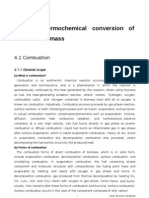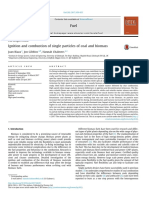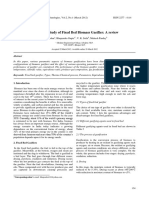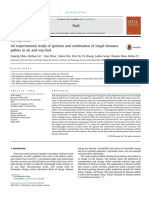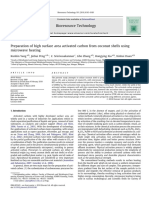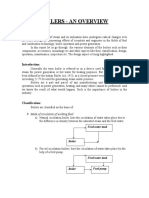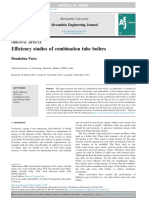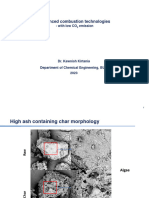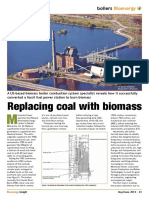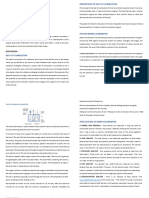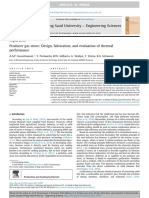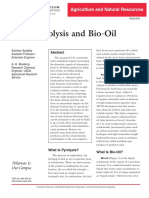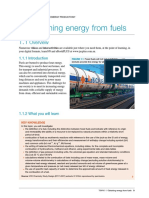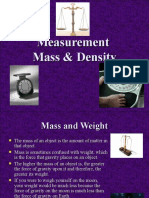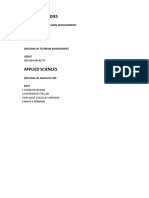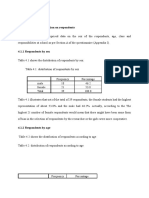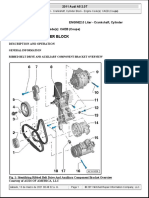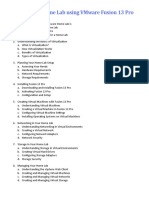A Review On Biomass Cook Stove
A Review On Biomass Cook Stove
Uploaded by
Manfred GithinjiCopyright:
Available Formats
A Review On Biomass Cook Stove
A Review On Biomass Cook Stove
Uploaded by
Manfred GithinjiOriginal Description:
Original Title
Copyright
Available Formats
Share this document
Did you find this document useful?
Is this content inappropriate?
Copyright:
Available Formats
A Review On Biomass Cook Stove
A Review On Biomass Cook Stove
Uploaded by
Manfred GithinjiCopyright:
Available Formats
IJSRD - International Journal for Scientific Research & Development| Vol.
3, Issue 05, 2015 | ISSN (online): 2321-0613
A Review on Biomass Cook Stove
Hitendra A Dabhi
M.E. Student (Thermal Engineering)
Department of Mechanical Engineering
A. D.Patel Institute of Technology, New V.V. Nagar, Gujarat-388121
Abstract— With respect to global issues of sustainable
energy and reduction in greenhouse gases biomass energy is
one of the key sources of renewable energy as a potential
source of energy in the future. Improved cooing stove can
bring significant benefits to rural publics due to reduced fuel
consumption and improved air quality. This work has been
carried out to develop, design and manufacture an applicable
type biomass stove by using locally available biomass fuels
like bamboo and neem wood. Biomass cook stove can be
used in applications like cooking and space heating problem.
This paper summarizes the research literature referred
relative to the Biomass cook stove. Fig. 1: Biomass cook stove principle
Key words: Cook Stove, Biomass, Water Boiling Test The rise in temperature devolatizes the biomass to
give off pyrolytic gases and a flame front is established in
I. INTRODUCTION the bed which propagates towards the grate leaving behind a
hot char zone at the top. A complex thermo-chemical
A. Combustion:
reaction takes place to produce a combustible gas.
As pyrolysis gases are emitted they will diffuse and mix The gas so produced passes through the hot char
with the surrounding air. If proper mixing with O 2 occurs zone allowing the tar (heavy hydrocarbon) to be cracked to
before leaving the reaction zone, and sufficient energy is give a relatively clean fuel gas. The product gases passing
available then the pyrolysis gases will combust. through the hot char zone react with the hot chars giving off
B. Biomass cook stove: relatively a clean energy rich gas.
These gases coming out of the bed typically
Biomass cook stove is basically a combustion device which
contains 16% CO, 12% H2, 3% CH4, 12% H2O (as gas),
burns biomass fuel more efficiently with reduced amount of
some higher hydrocarbons (5-6%) and remaining being N2.
emission and offers cleaner cooking energy solutions.
The gases when allowed to mix with the secondary air
Converting the fuel’s chemical energy into thermal
supplied directly to the combustion chamber burns with a
energy is done by combustion, thermal energy produced is
brilliant flame if the air fuel mixture is proper.
transferred to the cooking vessel by cook stove.
1) Natural draft- The easiest approach to obtain air into the
1) Types of Biomass Cook Stove;
combustion chambers is through naturally inducing air
The various types of Biomass cook stove are:
in which ambient air is introduced in as the hot air rises
According to combustion type (Since cold air is heavier than the hot air).
Direct Type 2) Forced draft- In this case the air is forced by using a
Gasifier Type fan. Ac supply is used to supply such a fans.
According to draft type 3) Direct combustion- The majority of the stoves is a
Natural draft direct combustion type of stoves where solid-fuel burns
Forced draft directly. The famous amongst direct combustion stove
According to construction Type is design of Larry Winiarski the popular Rocket stove.
Metallic 4) Gasifier Type- In the gasifier stove combustion takes
Ceramic place in two different parts. In the first part the fuel get
Hybrid burns and release gases while in the second stage at the
upper side of the stove air mixes and burns these gases.
C. Biomass Cook Stove: Gasifier stoves generally are quick-heated, energy and
The system comprises of a cylindrical reactor core of mild emissions efficient, lightweight, portable, and produce
steel with an external insulating cladding and a tapered bio char.
combustion chamber with air holes for secondary air supply
to be mixed with the product gas before combustion. II. LITERATURE REVIEW
In such a stove a packed bed of dry biomass (solid
This section summarizes the research literature referred
fuel) is burnt at the top and controlled quantity of air is
relative to the biomass cook stove.
supplied in the upward direction that causes partial
combustion of the biomass. A. Jessica Tryner, Bryan Wilson, Anthony Marchese [1]:
Five different configurations cookstoves were tested by
using two different fuels to determine how changes in stove
design, fuel type, and operating procedure affected
All rights reserved by www.ijsrd.com 465
A Review on Biomass Cook Stove
(IJSRD/Vol. 3/Issue 05/2015/108)
performance in terms of efficiency, carbon monoxide (CO) C. Murari Mohan Roy and Kenny W. Corscadden [3]
emissions, and particulate matter (PM) emissions. This study presents combustion and emission results
obtained using an Environmental Protection Agency (EPA)
wood stove for 15 biomass briquettes produced from a range
of feedstock including hay and switch grass.
Fig. 2: Five cook stove Tested
1) Stove 1:
Large and equipped with a chimney.
64 cm in height, weighed 37 kg.
Constructed primarily from steel sheet metal.
A refractory material lined the inside of the
combustion chamber and the area under the pot.
2) Stove 2:
Modified version of Stove 1 in which a cylindrical sheet
metal duct was added above the secondary combustion zone
to direct the flow of hot gases closer to the bottom of the
pot. Fig. 3: Emission measurement equipment’s
3) Stove 3: Non-waxed woody heating value of 17.91 MJ/kg.
Pot skirt was added. Grassy briquettes have an average heating value of 17.04
Chimney inlet was moved from the area under the MJ/kg. Waxed briquettes have an average heating value of
pot to the side of the pot skirt to force the hot gases to flow 28.89 MJ/kg. Overall combustion efficiency of grassy
around the sides of the pot. briquettes (74.64%) is very similar to that of woody
4) Stove 4: briquettes (74.21%).
It is 30 cm in height and was constructed of various steel 1) Emission Test
alloys. CO emission has a strong relation with excess air factor the
5) Stove 5: higher the excess air factor the lower the CO emissions.
The Peko Pe stove was also a small stove without a Grassy briquettes showed less average CO emissions (1718
chimney. mg/N m3) than that of woody briquettes (1890 mg/Nm3).
It is 25 cm in height and weighed 2.7 kg and was Grassy briquettes showed higher NOx emissions
constructed using 23 gauge stainless steel sheet metal. than woody briquettes, but SO2 emissions are very similar
Emissions of particulate matter with diameter of for both briquettes.
less than 10 μm were measured gravimetrically. CO D. Nordica MacCarty, Dean Still, Damon Ogle [4]:
emissions were measured at 1 Hz with Testo 335 and Testo
350 flue gas analyzers. Performance of 50 different stove designs was investigated
6) General Conclusion by Water Boiling Test (WBT) Version 3.0 to compare the
1) The measured emissions were lower when wood fuel use, carbon monoxide (CO) and particulate matter (PM)
pellets were used as fuel instead of corn cobs. emissions.
2) Stoves 1, 2, and 3 generally produced much higher Stoves tested fell under 6 main categories:
emissions than both Stoves 4 and 5. 1. Simple stoves without combustion chambers.
3) Stove 5 exhibited the lowest emissions overall. 2. Stoves with rocket-type combustion chambers
Unlike emissions thermal efficiency was not 3. Gasifier stoves
affected by fuel type. 4. Fan-assisted stoves
4) The thermal efficiency of a given design is 5. Charcoal-burning stoves
expected to depend primarily upon stove geometry. 6. Wood burning stoves with chimneys.
B. T. B. Reed and Ronal Larson [2]:
The cookstove working according to downdraft gasifier
principle was developed and evaluated.
Parameters measured-
Density is about 0.045 g/cm3.
It has moisture content about 19.3% on dry basis
and 16.4% on wet basis.
The fuel consumption rate is 1.89 kg/h and it has a
thermal efficiency of about 10.6%.
All rights reserved by www.ijsrd.com 466
A Review on Biomass Cook Stove
(IJSRD/Vol. 3/Issue 05/2015/108)
Fig. 5: Model of cook stove
1) Specification of stove and measurement-
The stove works on natural draft mode.
The thermal efficiency of the stove was recorded at
about 26.5% and it can be started, operated and
stopped with very low emissions.
It can use a wide variety of biomass fuels.
The produced wood gas burns with a blue flame
like liquid petroleum gas with a flame temperature
of 736°C.
Fig. 4: various cook stove used
During the testing the temperature of the outer
Aprovecho developed the Portable Emissions
surface of stove was recorded as about 105°C,
Monitoring System (PEMS), which performs as well as the
which indicates that there is still a chance to
laboratory system, but is less expensive and less
minimize conduction and radiation heat losses from
complicated. The PEMS consists of:
the outside skirt of cookstoves.
Collapsible suitcase-sized emissions collection
The flame temperature was recorded by a K-type
structure and exhaust system.
thermocouple and it was about 736°C during the
Flow grid, temperature sensor, and pressure drop
peak hour of combustion.
for exhaust flow measurement.
However, with increase in the efficiency of stove,
City Electrochemical CO sensor.
the amount of CO2 and CO emission inside the
Telaire NDIR CO2 sensor. kitchen has been reduced, which was measured
Specially-designed laser PM sensor for light- with the help of gas analyzers. It was found in the
scattering measurement of particulate matter. range of 18–20 and 1–3ppm respectively and
1) General Conclusion Made: within safe limits as recommended by the WHO.
Stoves without well-designed combustion chambers may
reduce fuel use in comparison to the three-stone fire but do F. Victor M. Berrueta, Rufus Edwards, Omar Masera [6]:
not necessarily decrease an emissions of CO and PM. This paper presents an energy evaluation of the Patsari
By using a pot skirt we can reduce fuel use and cookstove an efficient wood-burning cookstove developed
emissions by 25–30%. in Mexico. The evaluation uses three standard protocols:
With well operation gasifier stoves can reduce WBT which quantifies thermal efficiency and
particulate matter substantially, averaging 90% firepower.
improvement over the three-stone fire. The controlled cooking test which measures
Forced air stoves reduced fuel use by an average of specific energy consumption associated with local
40% and emissions by 90% over the three-stone fire. cooking tasks
E. N .L .Panwar and N. S. Rathore [5]: Kitchen performance test which evaluates the
behavior of the stoves in-field conditions and
This paper addresses about the studies of wood gas stove in
estimates fuel savings.
meeting cooing energy requirement.
Result showed that
The efficiency measured by stove was 30%.
The power of the devices varied between 6.4 kW to
9kW.
All rights reserved by www.ijsrd.com 467
A Review on Biomass Cook Stove
(IJSRD/Vol. 3/Issue 05/2015/108)
The fuel savings achieved by the Patsari were 55%
to 65% in comparison with the traditional one.
With sound technical design, critical input from
local users and proper dissemination strategies
improved stoves can significantly contribute to
improvements in the quality of life of rural people
with potential benefits to the surrounding
environment.
G. Ranjit Powar, Paris Yadav, Manish Chavan [7]
Highlighted the performance evaluation of forced draft cook
stove.
Fig. 7: Mass loss versus time for wood
The thermal efficiency measurement-
The radiation from the char bed to the vessel is
For pellet 40.33 per cent, Neem 36.47 per cent and
shown to contribute about 6 ± 1% to the efficiency.
Tur 33.43 per cent respectively.
Specific fuel measurement- I. Marian Bojko, Michal Branc[9] :
Specific fuel consumption of a stoves were 1, 1.2, It deals with the numerical model of combustion process of
1.44 kg/h for pellet, Neem, and Tur respectively. wood. Cross section through stove was created for
Power output measurement- evaluation of numerical simulation. The temperature contour
The power output of the cook stove for pellet, are shown in figure below:
Neem and Tur were found to be 3, 2 and 1.8 kW
respectively.
Fig. 6: Comparison of cold and hot eater boiling test
It was observed that pellet shown excellent results Fig. 8: Simplified model geometry of stove
in terms of thermal efficiency and power output rating as
compared with conventional fuel i.e. Tur and Neem. Pellet
was also found convenient to handling.
H. H. S. Varunkumar, N.K.S Rajan, H.S. Mukunda [8]:
The work reported here is concerned with a detailed
thermochemical evaluation of the flaming mode behavior of
a stove.
Reactive flow computational studies using the
measured gas composition over the fuel bed are used to
simulate the thermochemical flow field and heat transfer to
the vessel.
The overall flaming mode thermal efficiency of the
stove is 50–54% and the convective and radiative
components of heat transfer are found to be 45–47 and 5–
7% respectively. The efficiency estimates from reacting Fig. 9: Temperature contour results
computational fluid dynamics (RCFD) compare well with
J. J. Shankar kauley, Aniruddha Pandit [10]:
experiments. The results shows that:
The calculated data compare well with the This work presents a detailed theoretical study of solid fuel
experimental data. combustion in a domestic stove. In this work different
The heat transfer is a strong function of the vessel steady state as well as unsteady state combustion models
size such that efficiency increasing with increasing have been formulated, which include the description of all
the diameter of the vessel. the chemical and physical processes taking place during the
solid fuel combustion inside the stove. Steady state models
involve the calculation of effective maximum flame
temperature, suction of combustion air created by hot flue
gases inside the stove and the propagation of ignition front
All rights reserved by www.ijsrd.com 468
A Review on Biomass Cook Stove
(IJSRD/Vol. 3/Issue 05/2015/108)
inside the stove. Unsteady state mathematical model The heat release rate of the improved cookstove
involves all the processes occurring simultaneously or (metal stove with insulation) is 82% higher than the
sequentially during the solid fuel combustion such as traditional cookstove. Hence, the efficiency of the improved
moisture evaporation, devolatilization, pyrolysis and cookstove was 1.8 times higher than the traditional
homogeneous and heterogeneous combustion reactions. cookstove.
A clay stove can hold 3.6 times of heat energy as
compared to metal cookstove made of stainless steel.
REFERENCES
[1] Jessica Tryner and Bryan D.Willson, “The effects of
fuel type and stove design on emissions and efficiency
of natural-draft semi-gasifier biomass cookstoves”, July
2014
[2] T. B. Reed and E. Anselmo, “Testing & Modelling the
wood gas turbo stove”, July 1996
[3] Murari Mohon Roy and Kenny W. Corscadden, “An
experimental study of combustion and emissions of
biomass briquettes in a domestic wood stove”, May
2012
[4] Nordica MacCarty and Dean Stil, “Fuel use and
emissions performance of fifty cooking stoves in the
Fig. 10: Effect of bed height and flame temperature on laboratory and related benchmarks of performance”,
suction created by flue gases. June 2010
[5] N.L. Panwar and N.S. Rathore, “Design and
performance evaluation of a 5kW producer gas stove”,
April 2008
[6] Vıctor M. Berrueta and Rufus D. Edwards, “Energy
performance of wood-burning cookstoves in Mexico”,
June 2007
[7] Ranjit Powar and Paris Yadav, “Performances
Evaluation of Force Draft Gasifier Based Cook Stove”,
May 2014
[8] S.varunkumar, “Experimental and computational
Fig. 11: Validation of Temperature results studies on gasifier based stove”, August 2011
This unsteady state model gives the temperature [9] Marian Bojko, “A definition of the mathematical order
profiles at different locations inside the stove and fuel mass of combustion process in the stove”, January 2009
loss (combustion) rate, which can be further used to [10] Shankar kausley and Aniruddha Pandit, “ modelling of
calculate the power delivery by the stove during solid fuel stoves”, October 2009
combustion. The model shows good agreement with the
experimental results. These models can be used to find the
effect of stove geometry and fuel properties on the stove
performance parameters such as effective maximum flame
temperature, suction created inside the stove, propagation of
ignition front inside the stove, and fuel burn rate, which play
an important role in the design of such stoves for maximum
thermal efficiencies.
III. CONCLUSION
High power hot start give better results than the cold power
since it minimizes the initial thermal losses of the system
which occurs during cold start phase.
Thermal efficiency can be increased by using fan
since it provide better mixing of air with fuel and makes the
combustion proper.
Designed forced draft cook stove has efficiency
near about 40% and natural draft cook stove has efficiency
about 25%.
Increased air flow from the top that is secondary air
caused enhanced recirculation around the fuel bed brings in
more oxygen that reacts closer to the surface and transfers
additional heat enhancing the combustion in the fuel bed.
All rights reserved by www.ijsrd.com 469
You might also like
- UNIT 2 Heatlh and Safety in The Aviation Industry Lesson 1Document16 pagesUNIT 2 Heatlh and Safety in The Aviation Industry Lesson 1NekaNo ratings yet
- Boiler Stoker Firing PrincipleDocument4 pagesBoiler Stoker Firing PrincipleHefni OssyanNo ratings yet
- Aion Kinah GuideDocument163 pagesAion Kinah GuideEmile Sd0% (1)
- Thermochemical Conversion of BiomassDocument0 pagesThermochemical Conversion of BiomasshedayatinluvNo ratings yet
- Journal Int'l SubmitDocument11 pagesJournal Int'l SubmityunitaNo ratings yet
- Development of Furnace For Producing Activated Carbon: December 2010Document5 pagesDevelopment of Furnace For Producing Activated Carbon: December 2010Carlos JuarezNo ratings yet
- Thermochem Conversion of Ical BiomassDocument47 pagesThermochem Conversion of Ical BiomassKhoi HoangNo ratings yet
- Panduan PenilaDocument9 pagesPanduan PenilaMuna NadiyaNo ratings yet
- 4 PDFDocument4 pages4 PDFRasoulNo ratings yet
- The Design of A Radiation-Recuperative Heat ExchanDocument9 pagesThe Design of A Radiation-Recuperative Heat Exchanagbajelola idrisNo ratings yet
- Juan Riaza, Jon Gibbins, Hannah Chalmers: Full Length ArticleDocument6 pagesJuan Riaza, Jon Gibbins, Hannah Chalmers: Full Length ArticleLê Hoài AnhNo ratings yet
- Boilers: Vividha DhapteDocument18 pagesBoilers: Vividha DhapteAdinath ShirsatNo ratings yet
- Efficiency Studies of Combination Tube BoilersDocument10 pagesEfficiency Studies of Combination Tube BoilersSergio Alejandro Gonzales ArancibiaNo ratings yet
- Beohar Et Al. 2012 - Parametric Study of Fixed Bed Biomass GasifierDocument7 pagesBeohar Et Al. 2012 - Parametric Study of Fixed Bed Biomass GasifierStephNo ratings yet
- Nurhilal 2018 J. Phys. Conf. Ser. 1080 012024Document7 pagesNurhilal 2018 J. Phys. Conf. Ser. 1080 012024Emmanuel MatutuNo ratings yet
- Ijet V4i3p38 PDFDocument10 pagesIjet V4i3p38 PDFInternational Journal of Engineering and TechniquesNo ratings yet
- Corn and Biomass: StovesDocument8 pagesCorn and Biomass: StovesYranj Dave FortalezaNo ratings yet
- Fupeng Shan, Qizhao Lin, Kun Zhou, Yakun Wu, Wei Fu, Po Zhang, Lanbo Song, Chunyu Shao, Bolun YiDocument8 pagesFupeng Shan, Qizhao Lin, Kun Zhou, Yakun Wu, Wei Fu, Po Zhang, Lanbo Song, Chunyu Shao, Bolun YiLê Hoài AnhNo ratings yet
- Briquette BurnerDocument5 pagesBriquette BurnerInternational Journal of Research in Engineering and TechnologyNo ratings yet
- Design Features and Performance Evaluation of Natural-Draft, Continuous Operation Gasifier CookstoveDocument18 pagesDesign Features and Performance Evaluation of Natural-Draft, Continuous Operation Gasifier CookstoveBruno ImbroisiNo ratings yet
- Bustion Equipments and Firing Methods For FuelsDocument62 pagesBustion Equipments and Firing Methods For FuelsTarvesh KumarNo ratings yet
- Preparation of High Surface Area Activated Carbon From Coconut Shells Using Microwave HeatingDocument7 pagesPreparation of High Surface Area Activated Carbon From Coconut Shells Using Microwave HeatingTony ChuNo ratings yet
- Electricity From Woody BiomassDocument8 pagesElectricity From Woody Biomasssolar.suria.sdn.bhdNo ratings yet
- Boilers - An OverviewDocument22 pagesBoilers - An OverviewjsnathNo ratings yet
- Design and Fabrication of Coal Gasification Plant Prototype: Muhammad Sajjad, Jithin Ambarayil Joy, Dong Won JungDocument4 pagesDesign and Fabrication of Coal Gasification Plant Prototype: Muhammad Sajjad, Jithin Ambarayil Joy, Dong Won JungThu AungNo ratings yet
- Mechanical Engineering - 3035 - Module 4Document12 pagesMechanical Engineering - 3035 - Module 4chippuc39No ratings yet
- 7074 24595 1 SMDocument7 pages7074 24595 1 SMdurjoythermaxNo ratings yet
- The Design and Development of A Dual Fuel BurnerDocument6 pagesThe Design and Development of A Dual Fuel BurnerGidNo ratings yet
- Artigo FEN 2Document15 pagesArtigo FEN 2Ana Alice Fantini CunhaNo ratings yet
- Overview Of BoilerDocument9 pagesOverview Of BoilerNick IpaliNo ratings yet
- Iomass Onversion Echnologies: Emberga T.T., Uhiara F.E., Nwigwe C., Amadi R.ODocument6 pagesIomass Onversion Echnologies: Emberga T.T., Uhiara F.E., Nwigwe C., Amadi R.Omedhivya.raNo ratings yet
- Supervisor: Assoc. Prof. Bivek Baral (PHD) : Department of Mechanical EngineeringDocument2 pagesSupervisor: Assoc. Prof. Bivek Baral (PHD) : Department of Mechanical EngineeringsauravNo ratings yet
- E Ciency Studies of Combination Tube Boilers: Alexandria Engineering JournalDocument10 pagesE Ciency Studies of Combination Tube Boilers: Alexandria Engineering JournalJuan Sebastian AlarconNo ratings yet
- Lecture 5 6Document38 pagesLecture 5 6Anika FerdousNo ratings yet
- Unit 4 WteDocument17 pagesUnit 4 Wtevarshh001No ratings yet
- Expt6 HeatofcombustionDocument4 pagesExpt6 HeatofcombustionBo Marayag100% (1)
- Bhavesh ProjectDocument14 pagesBhavesh ProjectRahul LimbaniNo ratings yet
- Essay Ethics 1Document24 pagesEssay Ethics 1Fnur FatihahNo ratings yet
- 1A2. Circulating Fluidized Bed Combustion Technology (CFBC)Document1 page1A2. Circulating Fluidized Bed Combustion Technology (CFBC)kumarmm1234No ratings yet
- BoilerDocument28 pagesBoilerleeladharsahu503No ratings yet
- Desarrolo de La Pulverizacion de La Combusiton de Bbiomasa Con Un Camara de Precombustion 3Document14 pagesDesarrolo de La Pulverizacion de La Combusiton de Bbiomasa Con Un Camara de Precombustion 3dannyandrade1296No ratings yet
- Article From Coal To Biomass at MN PowerDocument3 pagesArticle From Coal To Biomass at MN PowerCory LukerNo ratings yet
- Module 4Document9 pagesModule 4violetanieves071083No ratings yet
- Gasification of BiomassDocument14 pagesGasification of BiomasskrishnaNo ratings yet
- Producer Gas Stove - Design Fabrication and Evaluation of Thermal PerformanceDocument8 pagesProducer Gas Stove - Design Fabrication and Evaluation of Thermal PerformanceyascheNo ratings yet
- Thermal Oxidizer BasicsDocument8 pagesThermal Oxidizer BasicsDiego1980b100% (1)
- 151 361 1 PBDocument7 pages151 361 1 PBElafanNo ratings yet
- Study of Effects of Temperature and Residence Time On Calorific Value of Torrefied BiomassDocument5 pagesStudy of Effects of Temperature and Residence Time On Calorific Value of Torrefied BiomassChethan GowdaNo ratings yet
- Biomass Cooking Stove For Sustainable Energy and EnvironmentDocument5 pagesBiomass Cooking Stove For Sustainable Energy and EnvironmentJohn Paulo BuzonNo ratings yet
- High-Temperature and Low-Oxygen Combustion Technology For Carbon Rotary KilnsDocument5 pagesHigh-Temperature and Low-Oxygen Combustion Technology For Carbon Rotary KilnsGauranka MoranNo ratings yet
- Lecture 4 - Biomass Energy Conversion Technologies and Processes - Direct CombustionDocument44 pagesLecture 4 - Biomass Energy Conversion Technologies and Processes - Direct CombustionBenard KalamboNo ratings yet
- Olio PDFDocument6 pagesOlio PDFAlessia IaccarinoNo ratings yet
- Biomass Combustion FSA-1056Document6 pagesBiomass Combustion FSA-1056cubicsupportNo ratings yet
- C 01 Obtaining Energy From FuelsDocument56 pagesC 01 Obtaining Energy From Fuelszaliha a-voyiNo ratings yet
- Spelling Test 10 Words WorksheetDocument8 pagesSpelling Test 10 Words WorksheetVaishnavi SharmaNo ratings yet
- Pns-Paes 242-2010Document21 pagesPns-Paes 242-2010Sheena ButacNo ratings yet
- Biomass in BoilerDocument13 pagesBiomass in Boilermbkluimp100% (2)
- Re Heating FurnaceDocument23 pagesRe Heating FurnaceRohit singh ChauhanNo ratings yet
- 2 2a2 PDFDocument1 page2 2a2 PDFanbarasanNo ratings yet
- Good Stoves Facilitation: How to Innovate and Change the WorldFrom EverandGood Stoves Facilitation: How to Innovate and Change the WorldNo ratings yet
- Design and Fabrication of Roll Bending Machine: April 2018Document3 pagesDesign and Fabrication of Roll Bending Machine: April 2018Manfred GithinjiNo ratings yet
- Monitoring and Measurement of Customer Satisfaction As A Process of Quality Management SystemDocument4 pagesMonitoring and Measurement of Customer Satisfaction As A Process of Quality Management SystemManfred GithinjiNo ratings yet
- Form 4 33 Relative DensityDocument8 pagesForm 4 33 Relative DensityManfred GithinjiNo ratings yet
- Course: 1601/106 Nominal Roll For July 2018 Exams S/No Index No. Candidates Names Id No Sign RemarksDocument5 pagesCourse: 1601/106 Nominal Roll For July 2018 Exams S/No Index No. Candidates Names Id No Sign RemarksManfred GithinjiNo ratings yet
- Rvtti Competition Application Form FurahaDocument4 pagesRvtti Competition Application Form FurahaManfred GithinjiNo ratings yet
- Course: 1601/106 Nominal Roll For July 2018 Exams S/No Index No. Names of Candidates Id No SignDocument4 pagesCourse: 1601/106 Nominal Roll For July 2018 Exams S/No Index No. Names of Candidates Id No SignManfred GithinjiNo ratings yet
- John Gitau Su Mo Tu We TH FR Sa 1 07:30-09:00: Town Campus January 2017 Teaching TimetableDocument1 pageJohn Gitau Su Mo Tu We TH FR Sa 1 07:30-09:00: Town Campus January 2017 Teaching TimetableManfred GithinjiNo ratings yet
- April Time TableDocument15 pagesApril Time TableManfred GithinjiNo ratings yet
- CbetDocument21 pagesCbetManfred GithinjiNo ratings yet
- Mat 241 Probability and StatisticsDocument2 pagesMat 241 Probability and StatisticsManfred Githinji0% (1)
- Business Studies: Diploma in Supply Chain Management PassDocument1 pageBusiness Studies: Diploma in Supply Chain Management PassManfred GithinjiNo ratings yet
- Tuition RecordsDocument3 pagesTuition RecordsManfred GithinjiNo ratings yet
- Candidates Names Admission Number Course DetailsDocument1 pageCandidates Names Admission Number Course DetailsManfred GithinjiNo ratings yet
- Candidates Names Admission Number Course DetailsDocument1 pageCandidates Names Admission Number Course DetailsManfred GithinjiNo ratings yet
- Town Campus Examination Sitting List: COURSE/GROUP .STAGE SERIES SUBJECT .Document1 pageTown Campus Examination Sitting List: COURSE/GROUP .STAGE SERIES SUBJECT .Manfred GithinjiNo ratings yet
- The Eldoret Polytechnic: End TermDocument10 pagesThe Eldoret Polytechnic: End TermManfred GithinjiNo ratings yet
- Candidates Names Admission Number Course DetailsDocument3 pagesCandidates Names Admission Number Course DetailsManfred GithinjiNo ratings yet
- Maize Production Constraints Final Edited3Document13 pagesMaize Production Constraints Final Edited3Manfred Githinji100% (1)
- 4.1 Background Information On RespondentsDocument6 pages4.1 Background Information On RespondentsManfred GithinjiNo ratings yet
- Knec 2016 JulyDocument2 pagesKnec 2016 JulyManfred GithinjiNo ratings yet
- Class Dme Jan /may 15 Subject Thermo/Steam/R & Ac Lecturer Githinji Date 20/7/16 Exam Stage 2 S/No Name Adm No Att CAT X/30 X/70Document3 pagesClass Dme Jan /may 15 Subject Thermo/Steam/R & Ac Lecturer Githinji Date 20/7/16 Exam Stage 2 S/No Name Adm No Att CAT X/30 X/70Manfred GithinjiNo ratings yet
- Section A: Compulsory (31 Marks) Answer All The Questions in This SectionDocument2 pagesSection A: Compulsory (31 Marks) Answer All The Questions in This SectionManfred GithinjiNo ratings yet
- A5 2011 2.0T CaebDocument329 pagesA5 2011 2.0T CaebjulianNo ratings yet
- Disadvantages in AAC BlocksDocument3 pagesDisadvantages in AAC BlocksGaurav JainNo ratings yet
- Lab 1Document2 pagesLab 1Sarah AliNo ratings yet
- Ccna Chapter 2 Point-To-PointDocument3 pagesCcna Chapter 2 Point-To-PointVerlin Grace CabalhugNo ratings yet
- Fityan Assyakirin Youth Unit Ar-Rijal Cup 2013 Indemnity FormDocument2 pagesFityan Assyakirin Youth Unit Ar-Rijal Cup 2013 Indemnity FormAssyakirin MosqueNo ratings yet
- Getting Started With DjangoDocument5 pagesGetting Started With DjangoCampus BitNo ratings yet
- ComAp Bi-Fuel Features cd2Document2 pagesComAp Bi-Fuel Features cd2Sanjeev PmNo ratings yet
- GRP - Composite Air Operated Grease Pump5Document3 pagesGRP - Composite Air Operated Grease Pump5rquinchia1No ratings yet
- AQT MSV 1 Suavizador Manual UnlockedDocument8 pagesAQT MSV 1 Suavizador Manual UnlockedEdgar CastroNo ratings yet
- Answer KeyDocument6 pagesAnswer KeyClaide John OngNo ratings yet
- PartographDocument45 pagesPartographMark Harris Tungpalan Subang100% (3)
- Characteristics of A Twisted Pair LineDocument6 pagesCharacteristics of A Twisted Pair LineAdan Rulo PerezNo ratings yet
- Read The Following Text and Answer The Questions That FollowDocument2 pagesRead The Following Text and Answer The Questions That FollowmikeyNo ratings yet
- Beat1550 PDFDocument56 pagesBeat1550 PDFSatish DabralNo ratings yet
- PDS MARINE VARNISH 02220 en-GBDocument1 pagePDS MARINE VARNISH 02220 en-GBDavid Josué ColqueNo ratings yet
- CETOP EduBook GeneralDocument33 pagesCETOP EduBook GeneralManuel VizcarraNo ratings yet
- Kincade Umn 0130E 21221Document145 pagesKincade Umn 0130E 21221Felipe TalonNo ratings yet
- Brett SteenbargerDocument12 pagesBrett Steenbargeranon-786387100% (4)
- Blanik L23 Manual WARNING Not Our Blanik PDFDocument70 pagesBlanik L23 Manual WARNING Not Our Blanik PDFEmerson JuncomNo ratings yet
- Digital Journey Experience FinalDocument67 pagesDigital Journey Experience FinalRantho Tarigan100% (1)
- Audit Report: Learning OutcomesDocument63 pagesAudit Report: Learning OutcomesChahil BapnaNo ratings yet
- Toolbox Talks Office SafetyDocument1 pageToolbox Talks Office Safetyfandhy AnwarNo ratings yet
- PNLE NursingDocument631 pagesPNLE NursingLenaj Ebron75% (4)
- Get The Social Work Field Placement: A Competency-Based Approach PDF ebook with Full Chapters NowDocument57 pagesGet The Social Work Field Placement: A Competency-Based Approach PDF ebook with Full Chapters Nowleitorteter38No ratings yet
- Base de Donnees GestionemployesDocument3 pagesBase de Donnees GestionemployesMohamed MeskiNo ratings yet
- Contour Based Object-Compliant Shape Control: Ignacio Cuiral-Zueco, Yiannis Karayiannidis, and Gonzalo López-NicolásDocument8 pagesContour Based Object-Compliant Shape Control: Ignacio Cuiral-Zueco, Yiannis Karayiannidis, and Gonzalo López-NicolásPablo Sari CedilloNo ratings yet
- SB As350-67.00.73eDocument31 pagesSB As350-67.00.73eanon_847285754No ratings yet
- 01 The Impact of Real Property Tax Knowledge and Awareness Towards Tax Compliance DraftDocument16 pages01 The Impact of Real Property Tax Knowledge and Awareness Towards Tax Compliance DraftMesina Joshua Ardie A.No ratings yet







